Author Archive
There is some progress in the IIIT front. Below is an excerpt from a Business Standard report. (In this regard, Orissa must insist that a new PPP based IIIT be established in Berhampur.)
… Nasscom has proposed that the IIITs be set up with an initial investment of Rs 30 crore, of which the government’s share should not exceed Rs 14.9 crore while the share of partnering companies should not be less than Rs 15.1 crore.
“A series of meetings have been held on the issue of finalising the PPP model for the IIITs. The final decision will be taken within a month’s time after which the institutes will be set up,” a senior HRD ministry official said.
Nasscom has also proposed that salary of faculty be linked to their output and the institutions have provisions of differential salary package.
As per the proposal, the IIITs will be autonomous degree awarding institutions. Each institute will have its own Board of Governors comprising 13 members, including one representative from the government.
The government will give a loan of Rs 100 crore to each institute with five years moratorium period and repayable within ten years time, Nasscom Vice-President Rajdeep Sehrawat said.
… As per the government’s plans, 20 new IIITs will be set up across the country in the Eleventh Plan period. Currently, there are four IIITs in the country. In north-eastern states and Jammu and Kashmir, where there are not enough industries, the government will bear the full establishment cost.
The IIIT, for which land will be provided by the states, will spread over 50 acres of area and have completely integrated campus with science and technology parks, he said.
Each institute will specialise on specific area of Information Technology. Each IIIT will be a centre of excellence in that domain. Nasscom has suggested that the institutes be set up in cities having modern amenities.
The IIITs will offer under-graduate, masters and PhD programmes. Each institute will have an intake capacity of about 1,000 students within a period of six to seven years of their functioning, he said.
June 19th, 2009
Update2: Pioneer reports the Orissa health minister saying that the state has been extremely co-operative on AIIMS and the allegations of Mr. Azad is baseless. The good news is that there has been some progress in the ground and
- Out of the 14 blocks of the AIIMS, the roof works of eight blocks have already been completed.
- An alternative road has already been constructed for the Sijua village and 90 per cent work has already been completed.
- Steps have been taken to remove the high-voltage transmission line.
Following is from Samaja:
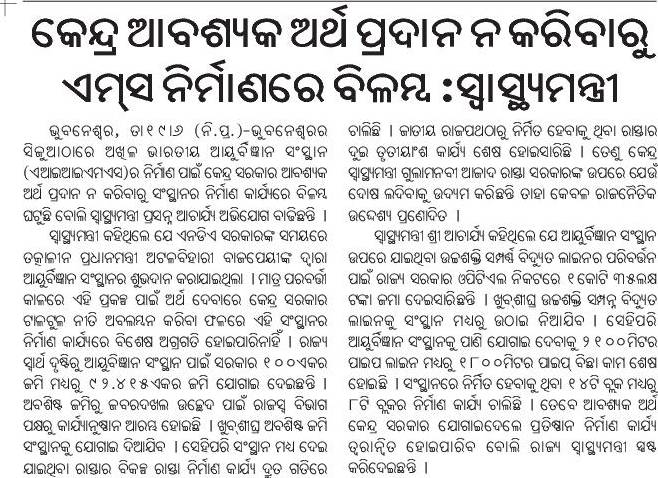
Update: TOI reports that Mr. Azad went to the AIIMS site and asked the project manager to work in three shifts and said that he will be monitoring the project every month. The first good news is that there is a project manager and some work is actually going on. 
The Central Cabinet minister of Health Mr. Ghulam Nabi Azad is visiting Orissa. His answers on the lack of progress with respect to AIIMS-like institute in Bhubaneswar is shocking. This institute foundation stone was laid by then PM Vajapayee prior to 2004 during the NDA government. Since then many reports have been made and tenders have been floated which we have been tracking here. And now Mr. Azad comes and blames the state government to hide the incompetency of the central Minitry of Health in making any progress. Note that the issue of tardy or zero progress on the AIIMS has been raised multiple times earlier, including many times in the parliament and someone even made a high court case in Bihar and this is the first time the state government is being partially blamed.
This is terrible. Mr. Azad should not play politics on such an importance issue and make sure tha the AIIMS-like institute is constructed as soon as posisble. Following are excerpts from a report in Business Standard which gives indication regarding the politics being played by Mr. Azad.
”I will review the progress in all the new AIIMS projects, including the one proposed to be constructed in Bhubanewar, to ensure these are ready in about three years. I will also speak to the construction agency,” Azad said.
Claiming that the steps taken by the state government for the ambitious Rs 820 crore project were slow and sluggish, Azad added that though the detailed project report for the Orissa AIIMS was ready proper land demarcation was yet to be completed.
The state should take quick steps to remove the high power transmission line at the site along with unauthorised structures and a small village relocated, the minister said.
On its part, the Centre was taking steps to bring momentum to the project, Azad informed adding he had spoken to Environment and Forests Minister Jairam Ramesh about the need for clearance to about 90 acres of the proposed AIIMS site here.
”Since Orissa badly needs an AIIMS, we are taking all steps to ensure that the project becomes operational at the earliest,” he said.To improve the health care facilities in Orissa, both the Centre and the state government must initiate steps for early completion of AIIMS here, Azad said.
Following is my email to the PMO and Mr. Azad on this topic.
Dear Esteemed Prime Minister and Health Minister:
Please do not play politics on the AIIMS-like institute in Bhubaneswar.
The foundation stone of this institute in Bhubaneswar was laid in 2003. In between 5 years of UPA government rule has passed in Delhi and nothing visible (beyond a boundary wall) has happened.
For the last 5 years, people of Orissa, representatives of Orissa (both MLAs, MPs), and Orissa CM have raised this issue and of no avail. In response to various parliament questions your ministers have always given one excuse or other for the delay.
And now for the first time Mr. Azad comes to Bhubaneswar and lays blame on the state government. (http://www.business-standard.com/india/news/centre-to-setnew-aiims-branches-in-three-years/64962/on ). This is playing politics on peoples lives and their health.
While the UPA government made a lot of progress on many fields (such as starting of classes on the new IITs, RTI, NREGS etc.) it has been grossly incompetent on the AIIMS issue.
To solve a problem, one must first admit that there is a problem. Please admit that your health ministry has been grossly incompetent and start over from there.
Please don’t play politics with people’s lives and their health. Please start the AIIMS-like institute in Bhubaneswar as soon as possible and to compensate for the delay as well as to take care of the backward areas of Orissa please immediately upgrade one of the exisiting medical college in the backward Western or Southern Orissa (one in Behampur or Burla) to the AIIMS level.
In West Bengal your are making a new AIIMS as well as upgrading Calcutta Medical College. In UP you will have a new AIIMS and are upgrading 3 medical colleges to AIIMS level.
In Mahasrashtra, Tamil Nadu, J&K and Andhra Pradesh you are upgrading two medical colleges to the AIIMS level. All these has been compiled from your web sites and PIBs and put together at https://www.orissalinks.com/archives/2111 .
Why not in Orissa? I sincerely hope that it is not because you had or have friendly governments in West Bengal, Mahasrashtra, Tamil Nadu, J&K and Andhra Pradesh and are eyeing UP and don’t really care about Orissa and its people?
Why do some other states get a new AIIMS as well as upgradation of multiple medical colleges to AIIMS level, and some get multiple upgradations to AIIMS level, while in Orissa no progress has happened for 5 years with respect to an announced AIIMS?
Sirs: Please pray tell us if this is not neglecting Orissa, what is?
Sirs: I again beg; Please do not play politics with people’s lives and health. Please expedite the establishment of AIIMS in Bhubaneswar and upgrade an exisiting medical college in the backward region of Orissa to the AIIMS level.
sincerely,
Chitta Baral
June 18th, 2009
Update: A tathya.in article says the following:
With setting up of an All India Institute of Homeopathic Science(AIIHS) in Orissa, Minister Health & Family Welfare is hoping to make this system of medicine will be more popular among the people. Mr.Achrya revealed here on 26 June that the State Government has posed for this institution to the Centre. Recently we have sent a proposal to the Department of Ayurveda, Yoga and Naturopathy, Unani, Siddha and Homeopathy (AYUSH), revealed Mr.Achrya. AYUSH is setting up All India institutions of Ayurveda and Homeopathy in various parts of the country. Keeping this in view, Orissa has sent the proposal entailing an investment of Rs.60-70 crores for the institution, said the Minister.
Note that in January 2008 the cabinet took decision to establish an All India Institute of Aurveda in New Delhi. See also this report in Hindu and this report in thaiindian.
Dharitri below mentions that it is one of the 5 such institutions that have been picked. On the other hand the site http://www.indianmedicine.nic.in/national-institute.asp lists the existing national institutes under the Department of AYUSH (Ayurveda, Yoga, Naturopathy, Unani, Siddha and Homeopathy). They are:
- NATIONAL INSTITUTE OF AYURVEDA (NIA) JAIPUR.
- NATIONAL INSTITUTE OF SIDDHA (NIS), CHENNAI
- NATIONAL INSTITUTE OF HOMOEOPATHY, KOLKATA
- NATIONAL INSTITUTE OF NATUROPATHY, PUNE
- NATIONAL INSTITUTE OF UNANI MEDICINE, BANGALORE
- INSTITUTE OF POST GRADUATE TEACHING & RESEARCH IN AYURVEDA, JAMNAGAR (GUJARAT)
- RASHTRIYA AYURVED VIDYAPEETH, NEW DELHI
- Morarji Desai National Institute of Yoga, New Delhi
Following is the report from Dharitri.
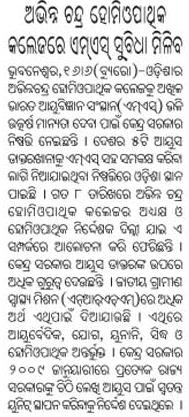
June 17th, 2009
Following is an excerpt from a report in Pioneer.
While one proposal has come from the State Planning and Coordination Department (SPCD), another was offered by the Defence Department. Though these proposals are in the preliminary state as observed by ADM Sribatsa Jena, …
According to sources, the State Planning and Coordination Department has asked the district administration to identify adequate land for setting up the medical college. The district administration also earmarked a land for the purpose at Remuna.
“We have intimated SPCD Secretary Bijay Arora regarding the land position and we have a patch of land adequate enough for the purpose at Remuna. The land was earlier earmarked for setting up a hospital by some private parties, who later abandoned their ideas,” said Jena.
Meanwhile, another inquiry has come from the Defence Department, asking the district administration for feasibility of setting up a medical college in line of the Armed Forces Medical College.
“We received intimation from the Defence headquarters before the general election and we are working towards it. The district Collector will shortly hold a meeting in this regard with the directors of the PXE and ITR,” said Jena claiming the administration is keen to convert the planning into reality.
Notably, the Defence (Army) has begun initiations to establish a training school at Amarda, acquiring land including Rasgobindapur in Mayurbhanj district, besides reviving the British time unused airstrip at the place.
June 16th, 2009
Update 2: Tathya reports that the site mentioned below is not chosen by MHRD. They pick a site near Sunabeda.
Update1: Tathya.in has a report comparing the two sites that are in contention.
Following is from Dharitri.
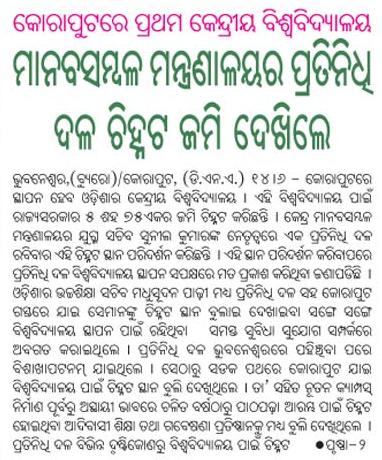


June 15th, 2009
Following is an excerpt from a report in Times of India.
About 124 students of rural schools were felicitated by chief minister Naveen Patnaik on Saturday for their brilliant performance at the National Math Olympiad.
Shradha Ranjan Grahacharya, a Class IX student at Kanakpur in Jagatsighpur district, wants to be a scientist and do research in her favourite subject, algebra. Although mathematics as always been her favourite, she began to take greater interest in the field after she was selected for the Rural Mathematics Olympiad (RMO) in 2006 when she was in Class VI.
"After I was picked for the RMO camp, I started liking the subject even more. At the camp, teachers taught us some easy methods to solving difficult mathematical problems," said Shradha, who stood first in the Junior Mathematics Olympiad, 2008.
According to IMA director Swadhinananda Pattanaik, there is a lack of interest in mathematics among parents and teachers, especially in government schools in villages. Hence, the IMA has decided to make teaching of mathematics an interesting and fun-filled activity.
"In most classrooms, there is little opportunity to understand maths beyond the level of solving equations. Typically, students just memorize mathematical facts without actually understanding the subject," he said.
Encouraging the young mathematicians, chief minister Naveen Patnaik said, "The IMA’s efforts are commendable, especially the special programmes to prepare students for premier institutes like IIT and NISER. This is the only institute of its kind in the country. I hope it will spread its wings globally very soon".
Besides the 124 young students, 33 senior students who performed well in the Regional and National Mathematics Olympiad were also felicitated. IMA is also conducting summer camps for undergraduate and post-graduate students.
June 15th, 2009
Following is from http://timesofindia.indiatimes.com/Columnists/SA-Aiyar-An-open-letter-to-Kapil-Sibal/articleshow/4653435.cms.
| SWAMINOMICS |
Back to school: An open letter to Kapil Sibal
14 Jun 2009, 0031 hrs IST, Swaminathan S Anklesaria Aiyar
|
|
|
Dear Kapil Sibal,
… for truly inclusive growth we must focus on improving basic education for the poor and historically disadvantaged classes. Poor people send their kids to government schools, but hardly any teaching takes place there, and the teachers are protected from disciplinary action by powerful trade unions. No chief minister dares antagonize these unions. Richer students supplement schooling with private tuitions, but this is unaffordable by poor students, who end up functionally illiterate after years of schooling. Lakhs of crores spent on education are wasted.
School vouchers can be one way forward. Parents can get outright grants per child in the form of school vouchers, which are redeemable only for expenses in a government or private school. Vouchers will empower poor people through choice in schools, just as democracy empowers them through choice in politics. Competition with private schools will improve government schools, just as competition from private airlines and banks have improved service in government airlines and banks.
But teachers’ unions hate competition or accountability, and oppose school vouchers. They also point out that the results of school vouchers in western countries have been mixed. In some states in the US, voucher students perform no better than those in government schools. In Sweden, on the other hand, voucher students fare distinctly better.
But in those countries, government teachers actually teach. This, alas, is not the case in India. And so desperate urban slum families are pulling their children out of free government schools and sending them to private schools, at great financial sacrifice. These private slum schools are hardly of high quality, yet are better than government schools having highly qualified teachers but little teaching. The very fact that slum-dwellers are sending kids to private schools in large numbers is the best evidence that private schools are better, whatever may be the experience in the US or Europe.
In Delhi, the Centre for Civil Society has started a small project offering school vouchers worth Rs 3,600 per year to 408 children. An independent evaluation shows that voucher children perform better in standardized tests than comparable children in neighbouring government schools; that parents find the teaching and infrastructure better in private voucher schools than government schools; and that over half the poor beneficiaries will be forced to send their children back to government school if the vouchers are withdrawn. This shows that vouchers are badly needed by the poor, and yield better results too.
The Delhi scheme is tiny. Some chief ministers have sought other ways to try and scale up vouchers. In Rajasthan, the former BJP government sought to persuade government teachers to start private schools, for which students would be given vouchers. Unsurprisingly, this failed to find many takers.
So, Kapil Sibal, let me propose an alternative. You should launch a pilot project, making funding available to states who are interested, and scale up after removing the inevitable glitches. The project should offer school vouchers to urban children of disadvantaged minorities — Dalits, tribals and Muslims. Only urban areas have multiple schools within walking distance of every locality, and that is a necessary condition for real choice.
Teachers’ unions will oppose this idea too. But their opposition will be muted since the benefits are limited to a small, historically disadvantaged section of the population. Besides, the idea will be supported by vote-banks of Dalits, tribals and Muslims, all of whom are wooed by politicians. Chief ministers will find it worthwhile to take on trade unions only if they are compensated by support from substantial vote banks.
In the Delhi scheme, activists spread information about vouchers in areas with 12 lakh citizens, of whom 1.2 lakh applied for vouchers. The vouchers were awarded through a draw of lots to a lucky few. Although only 408 children benefited, the project enthused over a lakh households, a number high enough to qualify as a vote-bank, and so interest politicians.
Teachers will see this as the thin end of the wedge, and launch agitations. One form of compromise could be to offer vouchers at least to girls from Dalit, tribal and Muslim families. Even the most cynical unions may feel ashamed of denying benefits to the most oppressed gender among the most oppressed classes.
Kapil Sibal, your new government is committed to affirmative action for the historically disadvantaged. This can be an excellent launching pad for school vouchers. Do not waste the opportunity.
I have written about this approach in the past. I think its time has come. An interesting fact not mentioned in the above article is that in many private schools teachers are paid less but the students do much better. A good example is the Sarasawti Sishu Mandirs. (Lets us ignore the religious organization behind those schools.) So pumping money to primary education is by itself not enough; nor is the the "Right to education act." What is needed is the "Right to Choice of Education."
I slightly disagree with the suggestion that this has to start in the urban areas. i think pilots should also be done in rural areas as the fact that government will be providing vouchers might actually encourage private organizations to open schools in those areas. With PMGSY the private schools in rural areas may even provide transportation.
June 14th, 2009
The following outline is from http://dtfnet.wordpress.com/2009/04/18/yashpal-committee-report/. (The full interim report is also at http://web1.du.ac.in/du/yashpal–report.pdf and http://www.jnu.ac.in/Yash_Pal_Committee.pdf)
Report of ‘The Committee to Advise on Renovation and Rejuvenation of Higher Education in India’
Pages: 1 2 3
Renovation and Rejuvenation of Universities
(An Interim Report)
1 March 2009
Table of Contents
Preamble
1. Executive Summary
2. The Idea of University
3. Problems of the Indian Higher Education Sector
3.1 Undermining undergraduate education
3.2 Low pedagogic quality
3.3 Distances: Within and outside
3.4 Isolation of the Indian Institutes of Technology
3.5 Divide between research bodies and universities
3.6 University as an inclusive space
3.7 State universities and affiliated colleges
3.8 Poor governance of universities
3.9 Interference in university functioning
3.10 Interference and loss of autonomy
3.11 Subversion of the principle of autonomy
3.12 Growth of private-commercial providers
3.13 Affordability problems
3.14 Other apprehensions about private universities
3.15 Unhealthy growth in the number of deemed universities
3.16 Multiplicity of regulatory systems
4. Recovering the Idea of University
4.1 Theory and practice
4.2 The challenge of local knowledge
4.3 Curriculum issues and syllabus-making
4.4 Work experience as an aspect of learning
4.5 Rehabilitating professional education in the university
4.6 Teacher education
4.7 Few premises on institutional autonomy of universities
5. Reforming the Regulatory System
5.1 Objectives of the commission for higher education
5.2 Restructuring Universities
6. Recommendations
Annex A
June 14th, 2009
Following is excerpted from a report in expressbuzz.com.
- This year 5,552 had applied for MCA courses in the JEE and 4,946 are on the merit list. Last year 6,422 candidates were on the chart.
- Last year, there were about 2,900 seats in both the government and private institutes that offered MCA programmes. This time around, the number is set to remain same.
- MBA: Last time there were 10,957 candidates on the merit list and this time it has dropped marginally to 10,652. The number of seats is likely to rise though – from about 3,200 in 2008 to 3,500.
- Pharmacy: In 2005, about 700 had taken admission but last year just 180 turned up. This time, 9,788 students are on the merit list but colleges are unsure.
- Engineering: There are at least 57,352 candidates put on the rank list of JEE even as the seat strength of colleges is on the rise. From about 20,650 seats in 63 colleges in 2008, it is expected to rise by another 6,500.“We expect 15 more institutes getting affiliation by the time counselling starts which will add about 3,600 seats. Besides, some existing institutes have sought a raise in seat strength too,’’
- Counselling by JEE Committee is likely to start from July 12.
June 13th, 2009
Following are some excerpts from that article.
… The university hospital, which will be built near the Puri-Konark Marine Drive, will be distinctive with its world-class facilities and infrastructure. The hospital will place equal emphasis on patient care, research, and teaching. It will be staffed by renowned doctors from India and abroad. …
Commending this initiative, eminent Indian cardiologist Dr KP Misra, said, "The hospital will serve as a regional hub for critical specialties including cardiology and diabetology. As a teaching and research hospital, it will attract leading researchers and specialists in medical science from around the globe. The university’s research agenda will prioritise public health solutions that address the most prevalent medical issues in the region."
On the occasion of the launch of the Vedanta University hospital project, a national seminar on ‘Optimum Medical Education and Ethics in Clinical Practice’ was organised at Bhubaneswar. The national conference was addressed by leaders in medical science of international repute, including Padma Vibhushan Professor MS Valiathan and Padma Bhushan Professor NK Ganguly.
The conceptual planning and design of the hospital has been prepared by the leading US-based hospital design firm Perkins + Will, which has previously designed state-of-the-art teaching and research hospitals at institutions such as Johns Hopkins University and the University of California at Los Angeles.
"The 500-bed multi-specialty hospital will commence during the first phase of the University. Orders for construction have already been placed with Larsen & Toubro Limited," added Sanjeev Anand Zutshi, Director of the project. The university has already initiated research programmes with local relevance. Dr Dipika Mohanty, a recipient of the Biju Patnaik award for Excellence in Science and Technology, has begun a Vedanta University-sponsored research project on interventions that can address the disproportionate prevalence of anemia in infants and children of Orissa.
The Vedanta University Hospital is a cornerstone of the institution’s larger commitment to serving public needs. Students and faculty across disciplines will be encouraged to engage with local challenges, search for solutions that contribute to the development of Orissa, and pursue research priorities that have real impact on the lives of people. In addition to initiatives in medicine, the first phase of the University will include schools of education, arts & sciences, engineering, management, and nursing. The hospital and initial academic programs will begin in 2011.
June 12th, 2009
Following is from http://www.cse.iitd.ernet.in/~jalote/misc/phd_surveyIITK-D-B.pdf linked from Prof. Pankaj Jalote’s home page at IIT Delhi.
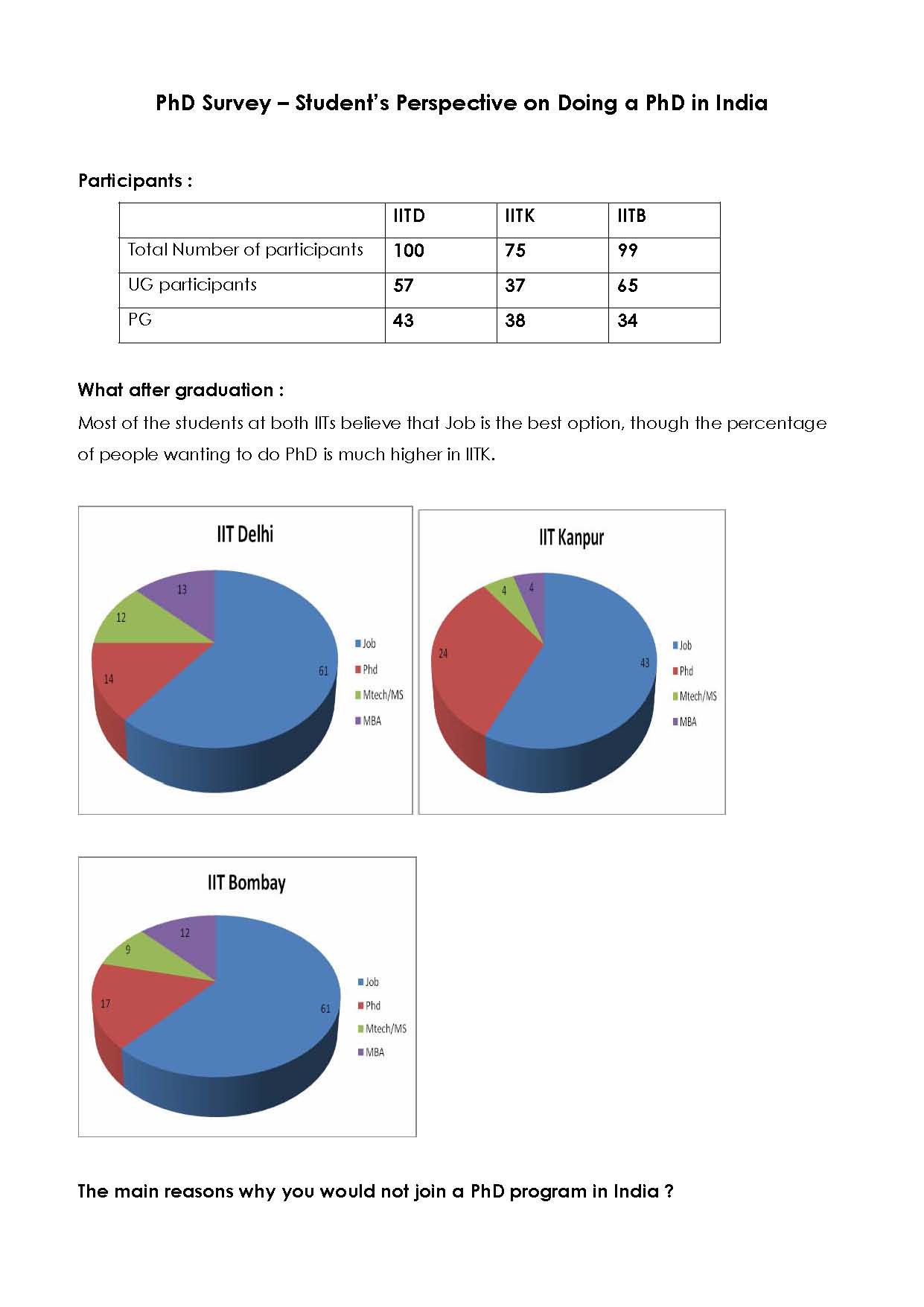

Based on the above survey, a simple way to build a private top quality university in India is to pay more than twice the amount that is paid to faculty at IITs/IISERs/NISER (starting with 100K/month to assistant professors) and to pay Rs 40K/month to Ph.D students. These Ph.D students may be asked to help in teaching as teaching assistants in US universities do. That way many top undergraduates will pursue Ph.D in this institute and by paying more than twice to the faculty the institution can attract top faculty. This could be a a data point for Vedanta University.
June 12th, 2009
Update on 27th April 2011: The Central University location has been changed to Bander Sindri near Ajmer and only 80 kms from Jaipur. The Innovation University (previsouly referred to as National University) aiming for world class is now pushed for Jaipur. [Times of India]
The panel set up by the CM of Rajsthan has picked the following places to recommend to the central government for the various national institutes and universities coming up in Rajasthan. (From a Times of India report and another Times of India report)
- IIT : Jodhpur
- IIM: Udaipur
- National University aiming for world-class: Ajmer
- Central university: Bikaner.
The committee also recommended:
- a "futuristic" heritage conservation and museology centre in Jaipur
- an institute of Food Technology in Hadoti region of Kota
Currently the following national institutions exisit or are being made in the following places in Rajasthan:
- NIT: Jaipur
- LNMIT (private but top-notch): Jaipur
- National law School: Jodhpur
- AIIMS-like institution (being made): Jodhpur
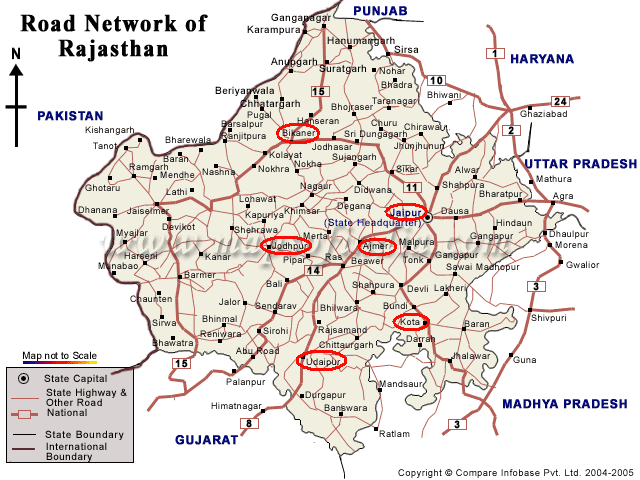
The institutions are nicely distributed between various cities of Rajsthan, although people of Jaipur and Kota are not happy. The population of these locations are:
- Jaipur (World Gazetteer 2009): 3.1 million (has inetrnational air connectivity)
- Jodhpur (World Gazetteer 2009): 988K – (332 kms from Jaipur; has air connectivity)
- Udaipur (World Gazetteer 2009): 457K – (400 kms from Jaipur; has air connectivity)
- Ajmer (World Gazetteer 2009): 604.7K – (131 kms from Jaipur)
- Bikaner (World Gazetteer 2009): 624.6K – (321 kms from Jaipur)
- Kota (World Gazetteer 2009): 823 K (242 kms from Jaipur)
In contrast in Orissa the distribution of national institutions are more Bhubaneswar centric. Following is the status:
- IIT: Bhubaneswar
- NISER: Bhubaneswar
- AIIMS-like (being made) : Bhubaneswar
- National Law University: Cuttack (part of Bhubaneswar metroplex)
- IIIT (state-funded) : Bhubaneswar
- National University aiming to be world class: Bhubaneswar
- Vedanta University (private): Puri
- NIT: Rourkela
- Central University: Koraput
- IIIT (centrally funded): state wants it in Berhampur; center has identified as Bhubaneswar
Unfortunately, one of the reason given behind the above selection is the lack of connectivity and the size of places. Following is some information on that.
- Bhubaneswar (World Gazetteer 2009): 1.67 million (has airport but no inetrnational connectivity)
- Rourkela (World Gazetteer 2009): 551 K (no air connections) – 334 kms from Bhubaneswar
- Berhampur (World Gazetteer 2009): 403 K (no air connections) – 160 kms from Bhubaneswar
- Koraput-Jeypore-Sunabeda: 200K+ (no air connections) – 499 kms from bhubaneswar
- Puri (World Gazetteer 2009): 185K – 60 kms from Bhubaneswar
- Sambalpur (World Gazetteer 2009): 258 K (no air connections) – 321 kms from Bhubaneswar
- Jharsuguda-Belpahar-Brajarajnagar: 200 K (no air connections) – 374 kms from Bhubaneswar; 50 kms from Sambalpur
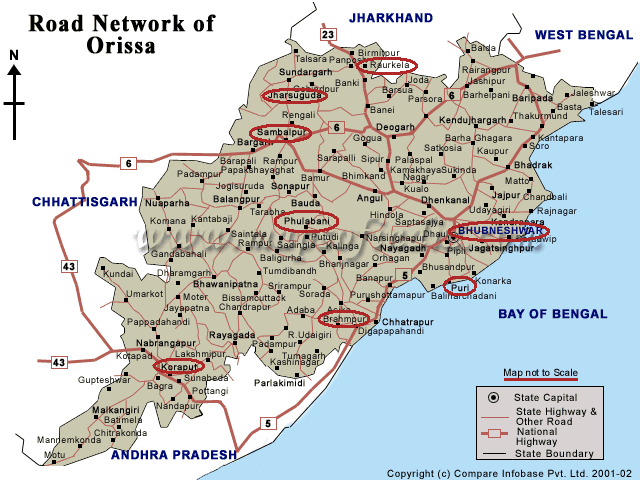
For the future, following are some of the steps that Orissa government needs to urgently take regarding developing more larger urban areas and having the national institutions more evenly distributed:
- Make sure the centrally funded IIIT is established in Berhampur
- Establish functioing airports in Jharsuguda, Rourkela and Koraput at the earliest
- Push for international flights to Bhubaneswar
- Push for upgradation of UCE Burla (Sambalpur area) to an IIEST (Indian Institute of Engineering Science & Technology)
- Push for the establishment of a branch of IGNTU (Indira Gandhi National Tribal University) in Phulbani
- Push for the establishment of IIM outside of the Bhubaneswar area
- Push for the establishment of a centrally funded KBK Inst of Engineering and Technology (along the lines of SLIET and ABAGKIET) in Kalahandi or Balangir.
- Push for upgrading another medical college (Berhampur or Sambalpur) to AIIMS level.
- Push for establishing NID in a location outside of Bhubaneswar
- Push for establishing NIPER in a location outside of Bhubaneswar
- Push for a BITS Pilani campus in a location outside of Bhubaneswar
June 12th, 2009
Following is from http://nest.niser.ac.in/nest09impnotice.html.
IMPORTANT NOTICE FOR THE SHORT LISTED CANDIDATES
OF
NEST 2009 EXAMINATION
All the short listed candidates whose names appear in the list have been sent an email asking for the preference to join NISER on or before 30th June, 2009. Alternatively, candidates whose name appears in the list can also download attached consent form and fill it up and send it to NISER on or before 30th June, 2009. If we do not receive the filled consent form from the short listed candidates before 30th June, 2009 it will be assumed that they are not interested in joining NISER or CBS.
The list of selected candidates based on the rank will be announced on the website of NISER on 2nd July, 2009. Selected candidates are requested to deposit the fee (Rs 19650 for General & OBC candidates and Rs 12150 for SC/ST candidates) in terms of a demand draft drawn in favor of "Director NISER" payable at Bhubaneswar before 10th July, 2009. If we do not receive the demand draft before 10th July, 2009, the admission stands cancelled and seat will be allotted to the lower rank candidates in the merit list.
Students claiming admission under reservation (OBC, SC, ST) should produce authentic certificates at the time of admission. Candidates without authentic certificates will not be admitted.
Please note that NISER has only 52 seats (Gen – 31, OBC – 9, SC – 8, ST – 4)
The consent form can be sent by any of the 3 methods given below.
1. direcly fill the online consent form. (will be available shortly)
2. download, fill and send it as mail-attachment to admissions@niser.ac.in or director@niser.ac.in
3. download, fill and FAX it to 0674-2302436
Choose whichever suits you. No need to send repeatedly.
Sd/-
DIRECTOR
June 12th, 2009
Following are some excerpts from the news report in expressbuzz.com.
- The National Institute of Science Education and Research (NISER), Bhubaneswar, is set to start PhD programmes from December this year.
- … It would be followed by an integrated PhD programme that would commence from August next year.
- … it plans to introduce new streams like Earth and Planetary Sciences, Environment Science and Computer Science by 2013.
- … the institution would move to its own campus at Jatni by 2013
- …. With the campus complete, the NISER would have about 1,000 UG and 700 PhD students along with 250 faculty members and 500 staff.
- … In the next two years, the intake would be 80 which would further go up to 200 in each wing by 2013.
- … Plans are also afoot to introduce a national combined entrance examination for NISER along with IISERs at Trivandrum, Bhopal, Mohali, Kolkata and Pune on the lines of IIT. At present, the IISERs are taking students from the extended merit list of IIT entrance examinations.
- NISER would also, from the next year, adopt one CBSE pattern school in the State to train its students to be absorbed in it for higher studies
Following is an excerpt from a report in Orissadiary.
- Prime Minister Manmohan Singh is expected to lay the foundation stone for the new campus of the prestigious National Institute for Science Education and Research (NISER) near here next month. Though the exact date is yet to be finalised, the foundation stone for our own campus is likely to be laid by the Prime Minister by the second week of July, NISER director Prof T K Chandrasekhar told the media persons.
Following are excerpts from a report in Business Standard.
- The total cost of setting up the new campus is Rs 770 crore. Construction work on the new campus is expected to commence by February 2010.
- In the beginning NISER would be affiliated to Homi Bhabha National Institute, a deemed university within the Department of Atomic Energy, for the award of degrees. At a later stage it will seek UGC approval to get the status of a deemed university for awarding degrees on its own.
June 12th, 2009
Following is from a news item in Pioneer.
… 75 candidates passing out from seven IITs in the country have joined its ranks as faculties.
In an independent recruitment drive, these BTech, MTech and PhD candidates from the IITs were appointed as faculties in different courses of KIIT. About half of the selected candidates have already joined and the remaining will be joining by the end of this month.
… Besides the IITians, more than 20 competent professors from different reputed universities across the country have also joined KIIT. Further, five law academicians of national and international repute have joined the KIIT Law School.
Faculty quality, especially in its engineering departments has been an issue for critics of KIIT. (This criticism is true for most private colleges and universities in Orissa.) I hope KIIT is able to nurture the abovementioned faculty, especially push the ones without a Ph.D to pursue and get a Ph.D. It should also clearly list its faculty and their qualification in its web pages so that visitors to its web pages are able to correct any misconception regarding KIIT’s faculty quality.
June 11th, 2009
By checking randomly I have found that people have gotton ranks beyond 39,000. No official word yet about the total number of qualified candidates for B.Engg and total number of seats.
In 2007, there were 43 colleges that took students based on Orissa JEE and ranks were initially given till 34835 and after the initial counseling there was another JEE to fill leftover seats and in two additional colleges (Indus and Templecity). In 2008 there were 18 more colleges and ITER became a deemed university, taking the total number of colleges taking students from JEE to 43+2+18-1=62. This year (2009) 25-30 new coleges are expected. We will post the details as they become available.
For students wanting to know what they can get based on their, a very very rough idea can be obtained by looking at the 2007 data at https://www.orissalinks.com/archives/1185. However, there were several new colleges in 2008 which were much better than the earlier colleges. Some of those are:
- Apex (run by the same people who run NIST Berhampur)
- Centurion (run by the same people who run JITM, Parlakhemundi)
(By the way, JITM Parlakhemundi is a good college and run by good people. Check their web page. The location is also beautiful. I visited it. For some reason students overlook it. Later this year or early next year there will be direct train to Parlakhemundi.)
Also, Templecity (two of its cofounders were the cofounders of KIIT) and Indus (its founder, an IIT Kharagur graduate and with a Ph.D from Houston USA, was instrumental in making NIST Berhampur a top college) that were established in 2007 but were not in the initial list are both good colleges.
This year couple of new colleges that are expected to be very good are:
June 10th, 2009
Next Posts
Previous Posts









